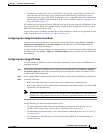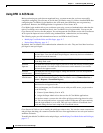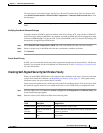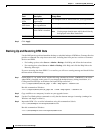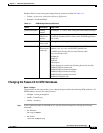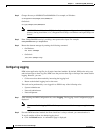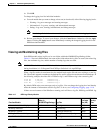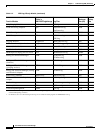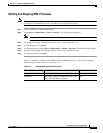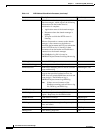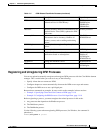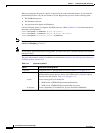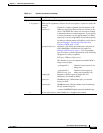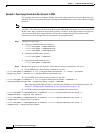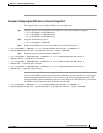
11-14
User Guide for Device Fault Manager
OL-11390-01
Chapter 11 Administering DFM (Advanced)
System Administration
DfmBroker DFM Broker maintains a registry about DFM
domain managers, which register the following
information with the broker when its
initialization is complete:
• Application name of the domain manager
• Hostname where the domain manager is
running
• TCP port at which the HTTP server is
listening
When a client needs to connect to the domain
manager, it first connects to the broker to
determine the hostname and TCP port where that
server’s HTTP service is listening. It then
disconnects from the broker and establishes a
connection to the domain manager.
The DfmBroker log file is located at
NMSROOT/objects/smarts/local/logs/brstart.log
.
None
DFMLogServer Controls DFM logs. None
DFMMultiProcLogger Handles processes with multiple threads. None
DFMOGSServer DFM Object Grouping Service Server evaluates
group membership.
CmfDbEngine, ESS
DfmServer Infrastructure device domain manager, a
program that provides backend services for
DFM. Services include SNMP data retrieval and
event analysis. The DfmServer log is
NMSROOT/objects/smarts/logs/DFM.log.
Note If there are two instances of the
DfmServer running, each will have a log
file, DFM.log and DFM1.log.
DfmBroker
DFMCTMStartup Handles interprocess communication. None
EPMDbEngine Event Promulgation Module (EPM) database
engine—Repository for the EPM module.
None
EPMDbMonitor EPM database monitor. EPMDbEngine
EPMServer Sends events to notification services. EPMDbEngine
FHDbEngine Fault History database engine—Repository for
alerts and events.
None
FHDbMonitor Fault History database monitor. FHDbEngine
FHPurgeTask Fault History purge task. None
Table 11-3 DFM-Related CiscoWorks Processes (continued)
Name Description Dependency



